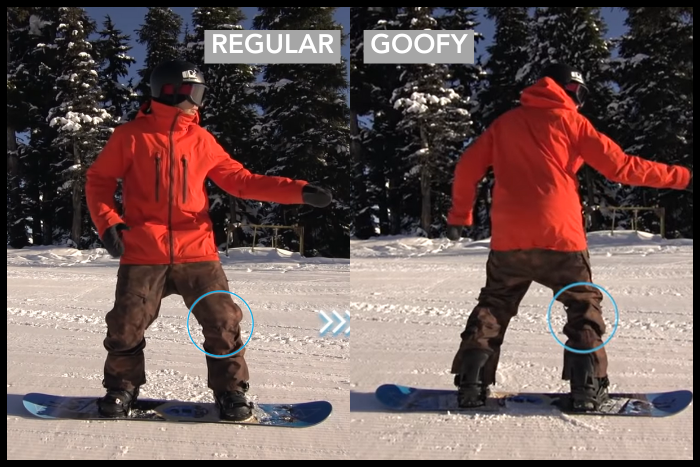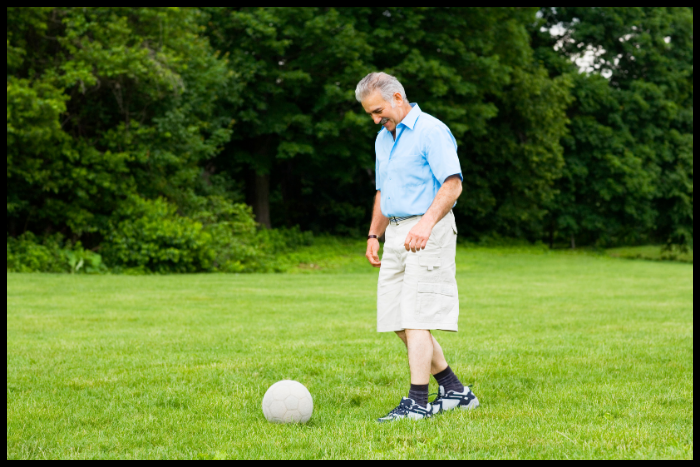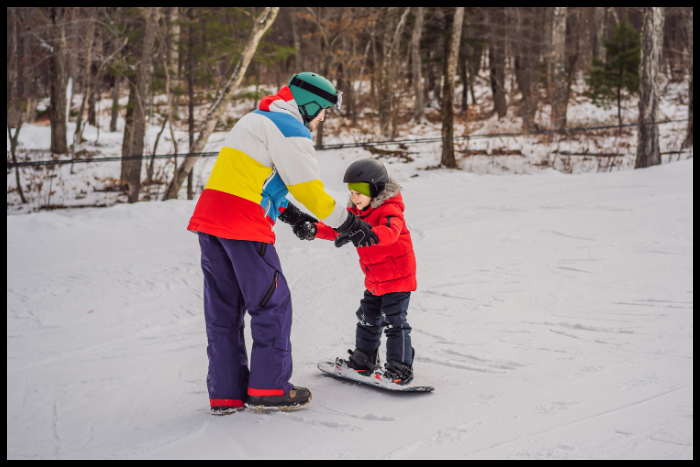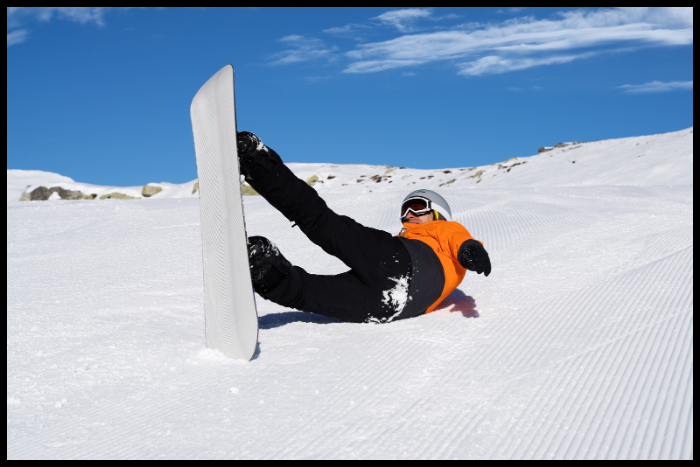When snowboarding, you ride with a sideways stance, as opposed to the forward-facing stance of skiing. Some beginner snowboarders find it tricky to determine their stance; by this, I mean which foot they lead with. There are two stance options: regular and goofy.
When a snowboarder rides with a goofy stance, they lead with their right foot. A regular stance rider leads with their left foot. There is no advantage or disadvantage to either stance; it is just what you’re naturally comfortable with. However, all snowboarders should practice “switch” riding often.
In this article, I’ll go into the details of goofy snowboarding, the symptoms of riding with the wrong stance, and how to work out if you’re a regular or goofy rider. I’ll also talk about riding “switch,” what it is, and why you should practice it as much as you can.
#1. Understanding Why Are Some People Goofy and Others Regular
A snowboarding stance refers to the position that you place your feet on a snowboard. There are two snowboard stances: you are either a regular or goofy rider.
The regular stance places the left foot forward while the goofy riders lead with their right foot.
Our brains are divided into right and left hemispheres. In a process called hemisphere lateralization, the left hemisphere controls the right side of our bodies.
In contrast, the right side of the brain controls the left side of our bodies. With this in mind, 70% of the population is right-handed, so more people ride with a regular snowboard stance.

Reason 1: Complexities in Snowboard Stance
However, it is not so clear cut, as some snowboarders are right-handed and goofy footers, and some are left-handed but regular footers.
This isn’t something you need to think about too much, as science still hasn’t figured out why this is.
But, later in this post, I will go into some tests you can do to determine which snowboarding stance you should adopt.
Reason 2: Hemisphere Lateralization and Riding Style
The interesting thing about hemisphere lateralization is that it may affect our riding style.
We use the left side of the brain for solving problems and making rational decisions, as well as fine motor skills, like writing. The right side of our brain looks after spatial orientation and 3D visualization.
Most creative and artistic people are right-brained and left-handed. This may be why most top slopestyle and freestyle snowboarders tend to be goofy riders.
For freestyle riding, you must be aware of your body in motion in three dimensions in the air while being creative, which are all things associated with being right-brained.
Some examples of pro snowboarders who ride with a goofy stance include Travis Rice, Torah Bright, Stale Sandbech, and Chloe Kim.
If you have ever seen these people ride, you will see that they are all creative and have incredible spatial awareness.
Reason 3: Association Between Handedness and Riding Stance
Most snowboarders ride with a regular stance due to being left-brained. Therefore, your front foot assesses the spatial surroundings while your back foot evaluates decisions and logical processes.
So, in general, according to World Surfing Association Doctor Tim Brown PhD, right-handed people tend to ride with a regular stance, and left-handed people are usually goofy riders.
Where Did The Term “Goofy” Come From?
There are a couple of theories of where the term “goofy” comes from.
The first is that the Disney character, Goofy, surfs in an old cartoon called “Hawaiian Holiday,” leading with his right foot, while pretty much every surfer had a regular stance back then.
The second theory is that most snowboarders, surfers, etc., ride in the regular stance with their left foot first, so some suggest that the right foot forward stance looks “kind of goofy.”
#2. Working out if You’re a Goofy or Regular Snowboarder
Some people naturally feel or know which foot they lead with when snowboarding. This comes from awareness of your body and your sporting background.
For example, if you already enjoy board sports, you will already have developed a natural feeling for which foot you lead with.
But I know people who skate with a regular stance but snowboard goofy, so it can be misleading. Also, surfers pivot on their back foot, while snowboarders pivot on their front foot.
Therefore, you will come across surfers who can snowboard with opposing stances.
If you’ve never strapped into a snowboard and the guy in the rental shop asks you what your stance is, there’s a good chance you won’t have a clue.
It makes a difference, as snowboard binding angles are often set up to favor which foot you lead with. They will ask you a few questions to work out which foot you should lead with, such as:
“Which foot do you lead with when you run?”
“Which foot would you kick a ball with?”
Their theory is that your answer to these questions is the answer to your snowboard stance. However, this isn’t always the case, as you may lead with either foot for different things.
So, how do you know how your bindings should be set up? Here are some excellent tests.

1. The Shove
Stand up and get a friend to push you from behind. They need to shove you just enough to put you off balance when you’re not expecting it.
This will cause you to step forward; if you steady yourself with your right foot, there’s a good chance you’re a goofy snowboarder.
On the other hand, you’re probably a regular stance rider if you step forward with your left foot.
2. Visualize Your Stance
Imagine sliding down a hill on a plank of wood. Your brain should automatically throw up an image of which way you stand on the plank.
Not everyone is good at visualization, so you may need to use another test to determine your stance.
3. The Slide
You may need to combine this test with one of the others, as it isn’t 100% accurate. I snowboard with a regular stance but slide leading with my right foot.
Put on some slippery socks and slide across a polished wooden floor. You will naturally lead with one particular foot each time. You may be a goofy snowboarder if you consistently lead with your right foot.
4. Stand on A Skateboard
Without thinking about it, stand on a skateboard. This will quickly highlight your preferred front foot, especially when you start to skate around.
As I mentioned earlier, this isn’t a foolproof test, as some people have different stances on snowboards and skateboards. But, as a rule of thumb, it’s a good test for most people.
5. The Step
The step test is an alternative to the shove test and a good one to use if you’re on your own.
Stand on a step, preferably at the bottom of some stairs or on a slightly raised platform, and lean forward with your knees locked. Eventually, you’ll need to step forward to stop yourself from falling over.
Whichever foot you land on should give you an indication of what stance to adopt while snowboarding.
#3. What Happens If You Ride With the Wrong Stance
I remember the first time I strapped into a snowboard. It was at an indoor snow center in the UK, and I was asked which foot I would lead with if I was going to run a race.
My answer was “right,” so they gave me a rental snowboard set up in a goofy stance.
It was my first snowboard lesson, so I was mainly sideslipping, doing the falling leaf, and half turns, so my stance wasn’t critical. However, it became tricky when I tried to complete turns.
I struggled to keep in control, finish turns, and do more than one turn before falling over, but I put it down to learning something new.
1. Discovering The Right Stance Through Past Experiences
But then I started thinking back to when I was even younger and my days of skateboarding.
I always led with my left foot forward, so when I returned for a practice session, I requested a snowboard with a “regular” binding setup.
Although still pretty rough, as I had to mirror what I had learned in my lesson, my technique improved immeasurably. I could just about link turns all the way down the slope.
I also have a guide on linking turns effectively to help you add this skill to your arsenal.
It just goes to show that sometimes you need to put a little more thought in before you try something new.
So, if you continue to struggle as a beginner snowboarder, you may want to try the opposite stance.
Alternatively, you could choose a twin-shaped snowboard and ensure your binding angles are the same, such as 15°-15°.
This would mean your snowboard would perform identically in either direction, giving you a chance to work out which foot feels best upfront.
You can then tweak your bindings to more suitable angles for your physiology and riding style.
2. Getting Professional Guidance
However, a good snowboard instructor can spot if you’re riding with the wrong stance. They will see how your body position affects your riding and any awkwardness in your technique.
If they are a proper snowboard instructor who cares about their students, they will either send you back to the shop for them to change your stance or do it themselves slopeside with a snowboard multitool.

Should You Learn to Ride Both Ways (Switch Riding)?
Pretty much every snowboard can be ridden backward or “switch.”
Some are easier than others; for example, a twin snowboard is symmetrical, so it will behave the same way whether your snowboard’s nose or tail is pointing down the mountain.
A directional snowboard is designed to work better when ridden forward, but you can still ride switch if you want to or need to.
My article on pros and cons of directional snowboards will help you gauge if they’re right for you.
Some snowboards are not designed to be ridden switch. Alpine race boards and powder snowboards are shaped to perform at their best riding forwards.
Their tails are often flat, short, or even have a “V” cut out to help them float in powder. Advanced riders can still ride these snowboards switch, but it wouldn’t be much fun and certainly challenging.
1. Why Ride Switch?
Being able to ride switch is an excellent skill to have. When freestyle riding, you can take off, and land jumps switch to add an extra element of difficulty and style.
Riding switch around the mountain is useful when you want to rest your legs.
For example, if you’re on a long calf-burning toe-side traverse, you can flip your board around to ride on your heel-side edge, giving your calf muscles a break.
Another benefit to riding switch is safety and convenience. You may find yourself in a situation where you’ve had to spin your snowboard 180°.
Flipping it back around may be impossible at that given moment for some reason. You may be on a narrow path or between some trees or skiers, and you need to ride it out until you get to a safe space.
Sometimes, being able to ride switch is excellent for spotting powder lines, too.
Often, you’ll be riding a slope, scoping for a good spot to drop into a powder field, but the slope’s edge is behind you on your blind side.
By riding switch, you can get a great view of the powder field and assess the best place to drop in.
2. Is Learning To Ride Switch Hard?
Learning how to ride switch seems awkward at first, like trying to write with your less dominant hand. However, with practice, you’ll soon look the same riding switch as you do forward.
I wish I had spent more time learning switch-riding when I started, as I would be a much better rider.
But it’s all too tempting to blast around the mountain in the direction you’re most comfortable with, especially when the snow conditions are good.
Now I live in a ski resort, I try to practice switch-riding more often. I regularly go out up the mountain on my own at lunch and practice techniques, including switch.
Where I live, there is a circuit consisting of various grades of slopes, drag lifts, and chairlifts that take you around my local ski area.
This winter, I have set myself a challenge to ride the whole circuit switch, including getting on and off the chairlifts backward.
It will take a few attempts and a lot of practice, but it will be a nice achievement to make me a better snowboarder.
Not everyone has this luxury, so I recommend aiming to do a whole run switch every time you go snowboarding.
Doing so makes a huge difference in your riding, and it is pretty rewarding to overcome the challenge.

Your Stance Comes Naturally to You – Don’t Overthink It
Although ensuring you ride with the correct stance is essential, it’s best not to overthink it.
If you put too much thought into it, you can easily get confused and constantly try to assess which way you should stand on your board.
I recommend going with your gut feeling, as it is probably the right thing to do.
But if you’re still unsure and finding it hard to control your snowboard, book a lesson. Your problem may lie in your technique or with your snowboard setup.
However, a snowboard instructor will know how to rectify the issue to help you become a better rider.
